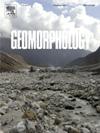Monitoring debris flow dynamics: insights from 4D-LiDAR observations in Ohya landslide, Central Japan
IF 3.1
2区 地球科学
Q2 GEOGRAPHY, PHYSICAL
引用次数: 0
Abstract
Debris flows, characterized by their destructive potential, rapid velocities, and extensive runout distances, pose significant hazards. Recent technological advancements have enabled the monitoring of debris flows using 4D (3D + time)-LiDAR (Light Detection And Ranging) from automotive-grade LiDAR for serial production, which is essential given the rapid temporal and spatial changes associated with debris flows. However, the data acquisition remains insufficient, particularly regarding the runout and deposition characteristics of debris flows traversing natural channels, which have yet to be fully elucidated. In this study, we installed 4D-LiDAR alongside video cameras at two locations; upstream and downstream, in the Ohya landslide scar in central Japan. This setup aimed to capture the three-dimensional surface morphology of the debris flows during its runouts, development, and deposition phases. As a result, we observed differences in longitudinal and cross-sectional profiles, surface morphology, and sediment deposition between fully and partly saturated debris flows. The cross-sectional profile showed a convex shape at the front of partly saturated debris flow. The surface morphology of debris flow, as indicated by the mean and standard deviation value of slope gradient and roughness, revealed that the front and middle sections of the surges exhibited similar tendencies, while the tail section displayed a different trend. This difference suggests that the standard deviation of slope gradient and roughness of flow surface were influenced by flow turbulence, particularly in saturated debris flows. Additionally, particle size also affects the standard deviation of slope gradient in partly saturated debris flows that are fully covered by boulders. However, the movements of boulders during the 0.1 s analysis interval of the LiDAR data may have resulted in poor correlations between the particle size determined from video images. The deposition of the surge front formed inverse slope topography relative to the original channel bed. These reverse gradients were consistently present during debris flow deposition, indicating that the topography decreased the mobility of subsequent flows, leading to the backfilling of sediments in the debris flow channel. We conclude that 4D-LiDAR monitoring is effective in enhancing our understanding of the runout characteristics of debris flows.
监测泥石流动力学:来自日本中部Ohya滑坡的4D-LiDAR观测的见解
泥石流具有破坏性、速度快、跳动距离广的特点,构成重大危险。最近的技术进步使得使用4D (3D +时间)-LiDAR(光探测和测距)从汽车级LiDAR进行批量生产的泥石流监测成为可能,考虑到与泥石流相关的快速时空变化,这是必不可少的。然而,数据的获取仍然不足,特别是关于流过自然河道的泥石流的跳动和沉积特征,这一点尚未得到充分阐明。在这项研究中,我们在两个地点安装了4d激光雷达和摄像机;上游和下游,在日本中部的Ohya滑坡疤痕。该装置旨在捕捉在其跳动、发展和沉积阶段的泥石流的三维表面形态。因此,我们观察到完全饱和和部分饱和泥石流在纵向和横截面剖面、表面形态和沉积物沉积方面的差异。剖面在部分饱和泥石流前缘呈凸形。从坡度和粗糙度的均值和标准差值可以看出,泥石流的表面形态在涌浪的前端和中段表现出相似的趋势,而尾段则表现出不同的趋势。这种差异表明,坡度的标准差和流面粗糙度受到流动湍流的影响,特别是在饱和泥石流中。此外,粒径还会影响部分饱和泥石流中完全被巨石覆盖的坡度标准差。然而,在激光雷达数据的0.1秒分析间隔内,巨石的运动可能导致视频图像确定的颗粒尺寸之间的相关性较差。浪涌前缘的沉积形成了相对于原河床的逆坡地形。这些反向梯度在泥石流沉积过程中一直存在,表明地形降低了后续流动的流动性,导致了泥石流通道内沉积物的回填。我们得出的结论是,4D-LiDAR监测可以有效地增强我们对泥石流跳动特征的理解。
本文章由计算机程序翻译,如有差异,请以英文原文为准。
求助全文
约1分钟内获得全文
求助全文
来源期刊

Geomorphology
地学-地球科学综合
CiteScore
8.00
自引率
10.30%
发文量
309
审稿时长
3.4 months
期刊介绍:
Our journal''s scope includes geomorphic themes of: tectonics and regional structure; glacial processes and landforms; fluvial sequences, Quaternary environmental change and dating; fluvial processes and landforms; mass movement, slopes and periglacial processes; hillslopes and soil erosion; weathering, karst and soils; aeolian processes and landforms, coastal dunes and arid environments; coastal and marine processes, estuaries and lakes; modelling, theoretical and quantitative geomorphology; DEM, GIS and remote sensing methods and applications; hazards, applied and planetary geomorphology; and volcanics.
 求助内容:
求助内容: 应助结果提醒方式:
应助结果提醒方式:


